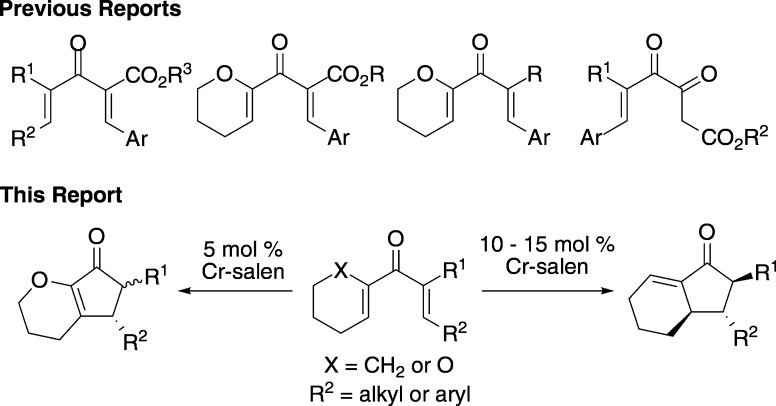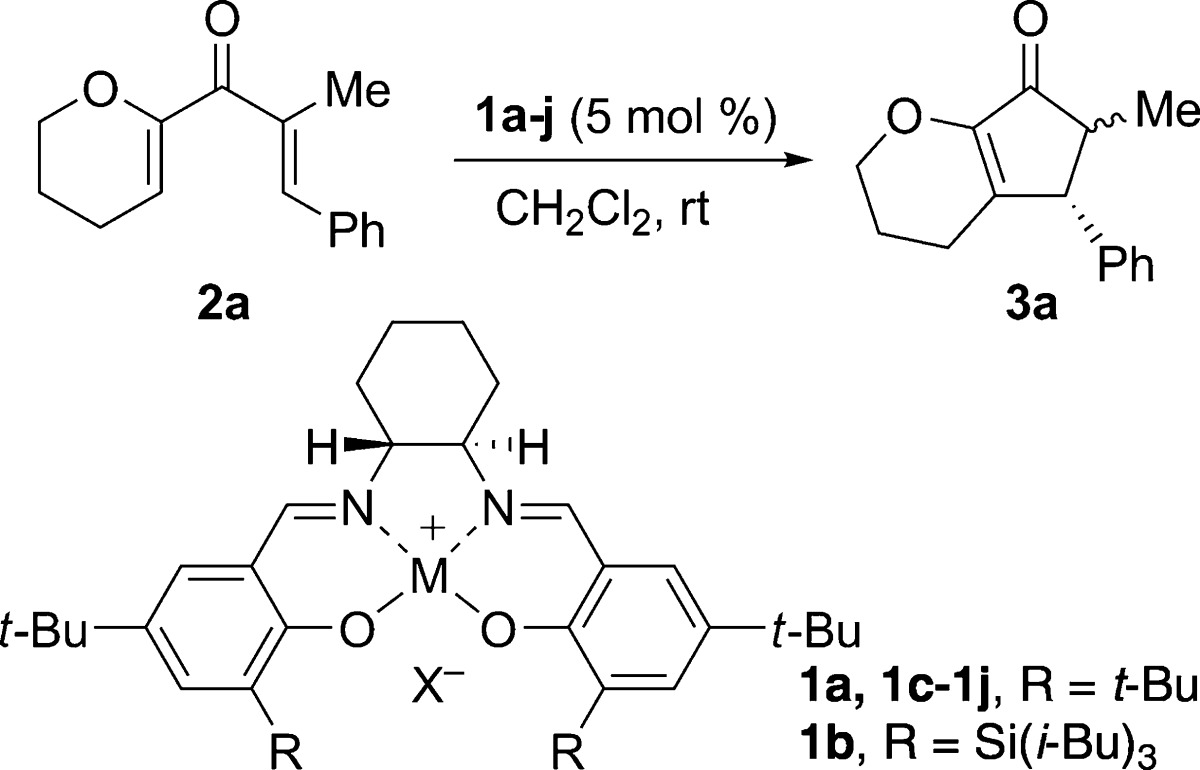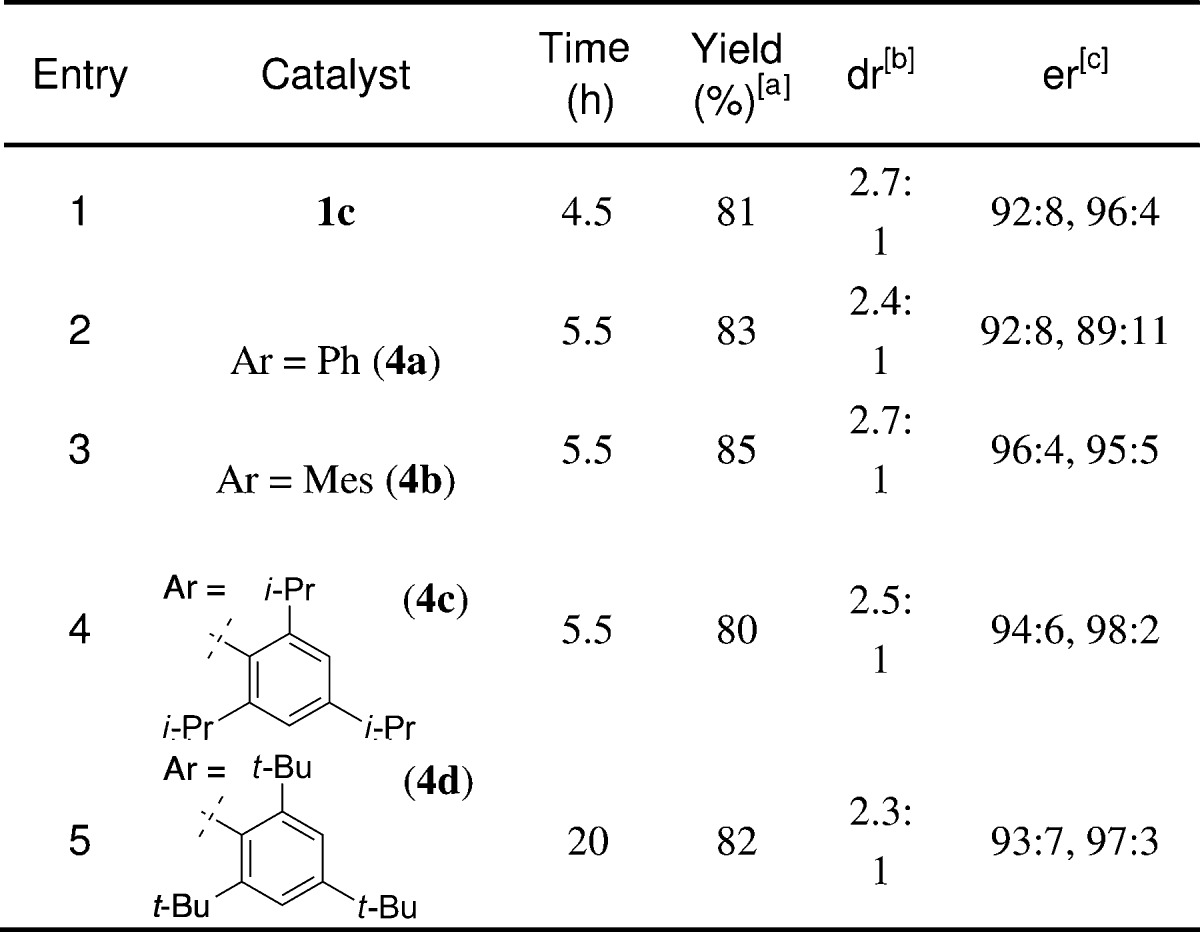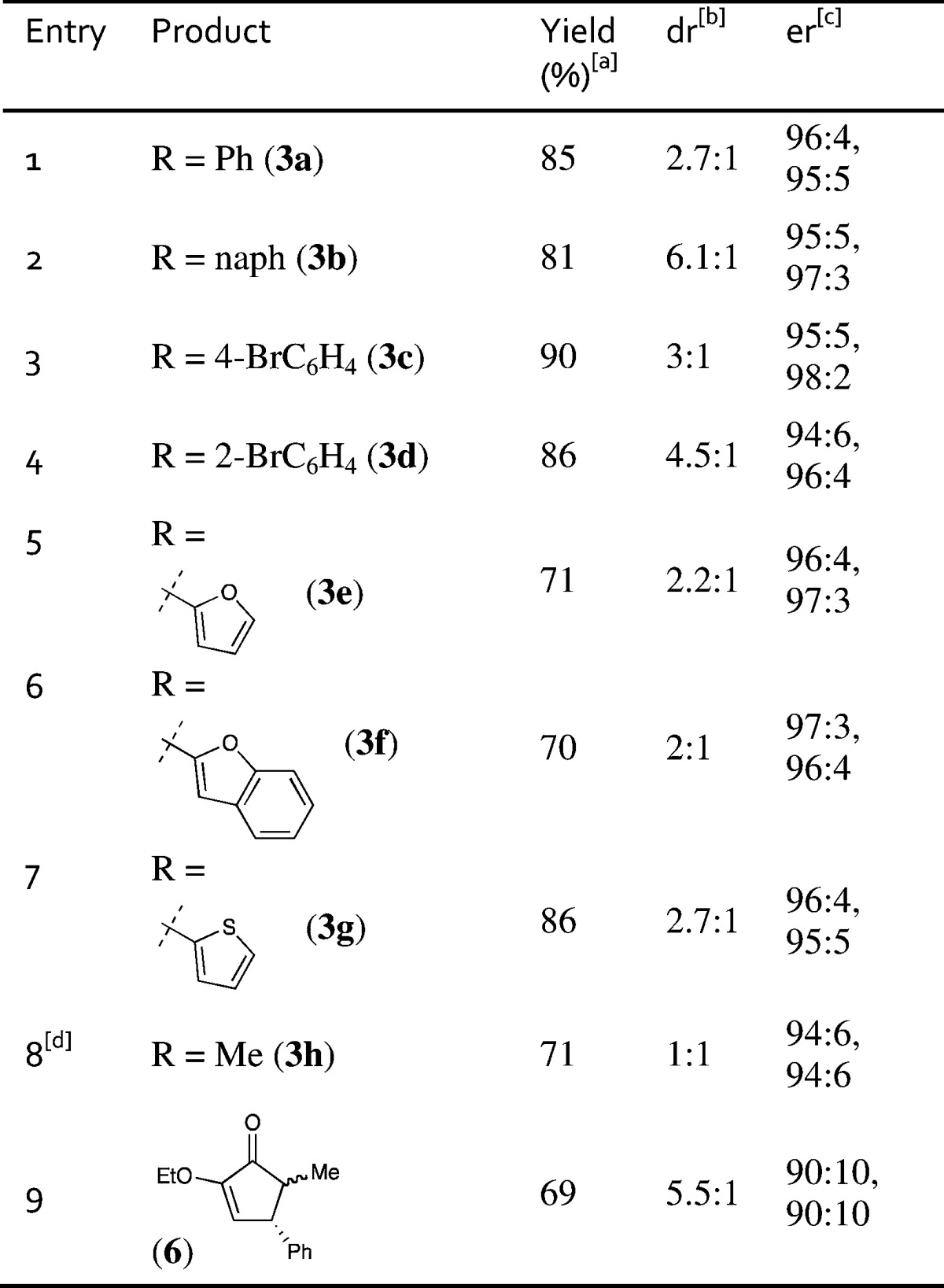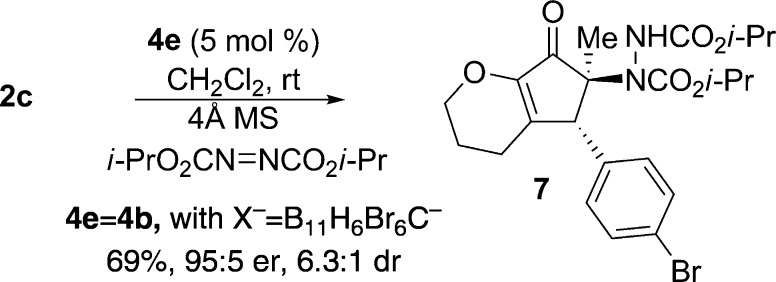Abstract
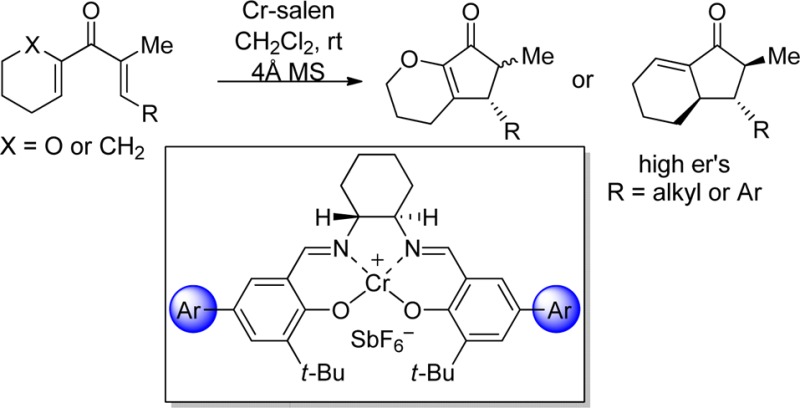
A novel class of chiral 5,5′-di(2,4,6-trialkyl)aryl salen-metal complexes have been developed and shown to catalyze highly enantioselective Nazarov cyclization reactions, giving rise to cyclopentenoids in 90:10–98:2 er. Significantly, the catalysts also promote, for the first time, highly enantioselective Nazarov reactions of “unactivated” dienones, producing hydrindenone products having in place three contiguous chiral centers.
The Nazarov cyclization reaction, a conrotatory 4π-electrocyclization of divinyl ketones, provides one of the most effective methods for the synthesis of functionalized cyclopentenones.1 The reaction has been investigated extensively and is often utilized for the synthesis of cyclopentenoid natural products.2 Catalysis of the Nazarov reaction has been the focus of many studies, and both Brønsted acid and Lewis acid catalyzed processes have been developed.3 The first highly enantioselective Nazarov reactions were reported in 2003 by Aggarwal and Belfield, who used chiral copper bisoxazoline (BOX) and pyBOX complexes as stoichiometric and substoichiometric catalysts.4 Contributions from several laboratories have led to the identification of other Lewis acidic metals and chiral scaffolds,5 as well as chiral Brønsted acids,6 for inducing torquoselectivity in the electrocyclization step. Enantioselectivity has also been realized upon protonation of the prochiral intermediate.5a,6b
Despite many noteworthy advances, significant challenges remain for the enantioselective Nazarov reaction. As noted by Vaidya et al., “Asymmetric catalysis has been limited to specific substrate types, particularly to the very reactive ones.”3a Tius and co-workers present a similar assessment of the enantioselective Nazarov reaction.3b Nearly all successes have been achieved with “activated” substrates, those possessing an α-alkoxy or α-electron-withdrawing group or both (Scheme 1).3 We report here a novel family of bulky 5,5′-di(2,4,6-trialkyl)aryl Cr-salen complexes that catalyze highly enantioselective Nazarov reactions. Significantly, the work provides the first examples of enantioselective Nazarov reactions of “unactivated” dienones as well as the first instances of such reactions to generate three adjacent stereocenters in the cyclopentyl core.
Scheme 1. Enantioselective Nazarov Cyclization Substrates.
In connection with our interest in the carbonyl-activating capability of chiral metal-salen complexes,7,8 we examined the use of such catalysts for the enantioselective Nazarov cyclization.9,10 Based on prior studies, including an X-ray crystal structure of a complex between a cobalt-salen and benzaldehyde,7c a one-point activation to the carbonyl was expected, wherein unsymmetrical coordination to the catalyst would impart torquoselectivity.
Initial studies focused on the Nazarov cyclization of alkoxy-activated dienone 2a in the presence of a number of readily prepared chiral salens (Table 1). Cobalt(III) salens 1a and 1b, containing 3,3′-di-tert-butyl and 3,3′-di(triisobutylsilyl)8 groups, respectively, were ineffective as catalysts, giving no conversion after 24 h (entries 1 and 2). By contrast, commercially derived chromium antimonate complex 1c catalyzed the cyclization in 9 h and afforded the product cyclopentenone 3a as a 2.8:1 mixture of cis/trans diastereomers, formed with good to high enantioselectivities (90:10, 95:5 er; entry 3).11 The introduction of 4 Å molecular sieves further increased the reaction rate and enantioselectivity, producing the product in 4.5 h, as a mixture of 92:8 er (cis) and 96:4 er (trans) diastereomers (entry 4). While the aluminum salen was catalytically more active, both it and manganese salens generated the product with low selectivity (entries 5 and 6). Solvent optimization studies in the presence of 1c and 4 Å MS revealed that methylene chloride was indeed the optimal solvent, with other solvents (DCE, toluene, diethyl ether, MTBE) either leading to lower er’s or deactivation of the catalyst (ethyl acetate, THF). A counterion survey revealed that commercially available catalyst 1f promotes the reaction slowly and gives the product with moderate er’s (entry 7). Exchanging the chloride with noncoordinating counterions, such as BF4, AsF6, and BArF, resulted in faster reactions and improved enantioselectivities (entries 8–10). The greatest improvement was observed with hexabromocarborane counterion, which converted divinyl ketone 2a completely to cyclopentenone 3a in <30 min.12
Table 1. Metal Survey for Salen-Catalyzed Nazarov Cyclization Reaction.
| entry | cat., M, X | additive | time (h) | conv (%)a | erb (dr)c |
|---|---|---|---|---|---|
| 1 | 1a, Co, SbF6 | – | 24 | NR | – |
| 2 | 1b, Co, SbF6 | – | 24 | NR | – |
| 3 | 1c, Cr, SbF6 | – | 9 | >95 | 90:10, 95:5, (2.8:1) |
| 4 | 1c, Cr, SbF6 | 4 Å MS | 4.5 | >95 | 92:8, 96:4 (2.7:1) |
| 5 | 1d, Mn, SbF6 | 4 Å MS | 48 | >95 | 60:40, 73:27 (1.9:1) |
| 6 | 1e, Al, Cl | 4 Å MS/AgSbF6 | 0.5 | >95 | 77:23, 59:41 (1.2:1) |
| 7 | 1f, Cr, Cl | 4 Å MS | 48 | >95 | 83:17, 86:14 (2.2:1) |
| 8 | 1g, Cr, BF4 | 4 Å MS | 8 | >95 | 86:14, 93:7 (2.6:1) |
| 9 | 1h, Cr, AsF6 | 4 Å MS | 8 | >95 | 85:15, 92:8 (1.7:1) |
| 10d | 1i, Cr, BArF | 4 Å MS | 3 | >95 | 91:9, 93:7 (1.8:1) |
| 11 | 1j, Cr, Cl | 4 Å MS/AgB11H6Br6Ce | 0.5 | >95 | 90:10, 95:5 (2.8:1) |
Determined using 1H NMR.
er of cis and trans diastereomers determined using chiral HPLC.
dr determined using 1H NMR.
BArF=tetrakis[3,5-bis(trifluoromethyl) phenyl]borate.
AgB11H6Br6C = silver hexabromocarborane; NR = no Reaction. See SI for details on tentative assignment of stereochemistry of the product.
To realize further increases in torquoselectivity, we considered modification of the salen scaffold. Although replacement of the 3,3′-groups with bulkier groups had proven successful for activation of the aldehyde carbonyls in Diels–Alder and carbonyl ene reactions,7,8 such groups were expected to impede coordination to the dienone carbonyl, which is flanked with sterically demanding substituents.13 On the other hand, introduction of the correct substituents at the 5,5′-positions could further accentuate the subtle asymmetric topology of the salen framework. Specifically, 2,6-disubstituted aryl groups at this position would be forced to sit perpendicular to the salen aryls and thus project above and below the catalyst plane. Such bulky aryl groups have been successfully incorporated into a number of chiral Lewis acid catalysts, such as those by Terada14 and Yamamoto.15 The biaryl salicylaldehydes required for the modified salens were synthesized in a single step from the corresponding bromosalicylaldehyde using a Suzuki-Miyaura cross-coupling protocol and then converted to the desired chromium complex using established methods.16
The results of the Nazarov cyclization using the novel 5,5′-diaryl substituted salens are summarized in Table 2. Compared to the parent t-butyl-substituted salen, the aryl-substituted salens generally gave higher enantioselectivities. Whereas the simple 5,5′-diphenyl-substituted salen complex (4a) was modestly selective, the corresponding mesityl substituted salen (4b), in which the biaryl units are expected to be in a perpendicular arrangement, gave the product with >95:5 er for each diastereomer (entries 2 and 3). A further increase in the size of the substitutents on the 5,5′-diaryl groups did not continue to improve torquoselectivity. Thus, the i-Pr and t-Bu catalysts (4c and 4d, respectively), while superior to 1c and 4a, gave higher er only for the minor product diastereomer. The slower reaction rate for the t-Bu catalyst (entry 5) is consistent with the original hypothesis that ortho substituents on the 5,5′-diaryl groups would affect the coordination and orientation of reactants.
Table 2. Use of 5,5′-Diaryl-Substituted Chromium(III) Salen Complexes for the Asymmetric Nazarov Cyclization Reaction.
Isolated yields.
dr’s determined using 1H NMR.
er’s of cis and trans diastereomers determined using chiral HPLC.
Having identified the mesityl-substituted chromium-salen complex 4b as optimal, we next examined the scope of these enantioselective Nazarov cyclizations (Table 3). A broad range of aromatic and heteroaromatic groups were tolerated at the β-position of the dienone substrates, with the cyclopentenone products being formed in good yields and er’s. The higher diastereoselectivities seen in entries 2 and 4 appear to correlate with the effective size of the β-substituent. Of interest is the result shown in entry 8, the cyclization of β-methyl dienone 2h to give product 3h in good yield and er. Since β-alkyl substrates undergo Nazarov cyclization more slowly than β-aryl substrates, this reaction was carried out using 4b but with hexabromocarborane counterion. Entry 9 demonstrates the ability of catalyst 4b to impart asymmetry in the cyclization of acylic dienones.17
Table 3. Scope of Salen-Promoted Enantioselective Nazarov Cyclizations.

Isolated yields.
dr’s determined using 1H NMR.
er’s of cis and trans diastereomers determined using chiral HPLC.
Catalyst 4e (4b but with hexabromocarborane counterion) was used.
Absolute stereochemistries for 3b–h and 6 were assigned to correlate with 3a.
A few cascade sequences have been reported wherein the penultimate enol or metal enolate intermediate in an enantioselective Nazarov reaction is intercepted with a halogen or carbon electrophile.3,5 Our longstanding interest in nitrogen-containing compounds motivated us to briefly examine a tandem process that would terminate with the formation of a C–N bond to the enol intermediate. We have found that inclusion of diisopropyl azodicarboxylate in the reaction mixture affords the Nazarov cyclization/azination product. It is of interest to note that diastereoselectivity for the tandem process was higher than in the original cyclization (Scheme 2).
Scheme 2. Tandem Enantioselective Nazarov Cyclization/Azination Reaction.
Given the success observed with “activated” substrates, we next examined the use of the novel bulky chromium-salen complexes as catalysts for enantioselective Nazarov cyclizations of unactivated dienones. Thus, treatment of the simple dienone 8a with catalyst 4b promoted a smooth cyclization to afford cyclopentanoid product 9a in 60% yield and with 95:5 er (Table 4, entry 1). Interestingly, 1H NMR analysis revealed that the major product was not the tetrasubstituted alkene, as before, but was instead the bicyclo[4.3.0]non-1-en-9-one product (9a) with the two methyl groups in a trans arrangement. The cis product and the expected tetrasubstituted product were observed in only trace amounts. Divinyl ketones 8b–h were also converted to the corresponding cyclopentanoids, yielding compounds 9b–h with good er and high diastereoselectivities (entries 2–8). The unactivated substrates were slower to react and required higher catalyst loadings and longer reaction times. For example, dienone 8a and 8b required 15 mol % of 4b and 60 h reaction time, while dienones 8c–8h proceeded in the presence of 10–15 mol % catalyst for 48 h. The above results represent, to our knowledge, the first highly torquoselective catalytic Nazarov cyclization reactions of unactivated dienones. These examples also provide the only examples of enantioselective Nazarov cyclization reactions to generate a cyclopentane with three stereogenic centers.
Table 4. Scope of Salen-Promoted Enantioselective Nazarov Cyclizations of Unactivated Dienones.
| entry | product | yield (%)a | drb | erc |
|---|---|---|---|---|
| 1d | R = Me (9a) | 60 | >20:1 | 95:5 |
| 2d | R = Et (9b) | 65 | >20:1 | 93:7 |
| 3e | R = Ph (9c) | 78 | >20:1 | 93:7 |
| 4e | R = 4-BrC6H4 (9d) | 78 | >20:1 | 97:3 |
| 5e | R = 4-MeC6H4 (9e) | 76 | >10:1 | 90:10 |
| 6d | R = 2-furyl (9f) | 55 | >10:1 | 92:8 |
| 7e | R = 2-benzofuryl (9g) | 56 | >10:1 | 92:8 |
| 8d | R = 2-thienyl (9h) | 62 | >8:1 | 90:10 |
Isolated yields.
Diastereoselectivity determined by 1H NMR.
er values were determined using chiral HPLC.
15 mol % catalyst loading.
10 mol % catalyst loading.
The absolute stereochemistry of the salen-promoted Nazarov cyclization product, enone 9e, was determined through X-ray crystallography of its dibromo derivative 10, formed in high diastereoselectivity (dr = 20:1, Scheme 3).18 The crystal structure also confirmed the relative stereochemistry assigned to the three chiral centers introduced upon cyclization. A rationale for the observed torquoselectivity can be put forth by considering an octahedral complex between the substrate and the Cr-salen, in analogy with the previously reported structure of benzaldehyde-Co-salen complex (Scheme 4).7c Steric factors should favor coordination to the carbonyl lone pair away from the cyclohexenyl unit, with the substrate residing in the more open quadrant. In this arrangement, a counter-clockwise conrotatory cyclization, as viewed from the carbonyl group oxygen, would move the R group into a less-congested environment, away from the bulky mesityl group, whereas a clockwise cyclization would have the opposite effect.
Scheme 3. Absolute Stereochemistry of Nazarov Product 9e.

Scheme 4. Proposed Model to Rationalize Enantioselectivity.

In summary, a new class of chiral 5,5′-diaryl-substituted metal salens was developed and shown to catalyze highly torquoselective Nazarov reactions, very likely through a one-point activation mode. Significantly, the catalysts also promote, for the first time, highly enantioselective Nazarov reactions of unactivated dienones, producing hydrindenone products having in place three contiguous chiral centers.
Acknowledgments
This work was supported by the NIH (GM069990). Fellowship support to G.E.H. from the UNCF/Merck, GlaxoSmithKline, and Bristol-Myers Squibb is gratefully acknowledged. We thank Mr. Mohammad Haidar for preparing initial batches of compounds 4a and 4b, and Dr. Ian Steele (University of Chicago, Department of Geophysical Sciences) for X-ray structure determination of compound 10.
Supporting Information Available
Detailed methods and compound characterization. This material is available free of charge via the Internet at http://pubs.acs.org.
The authors declare no competing financial interest.
Reference 3a was incorrect in the version published ASAP March 25, 2013. The corrected version was re-posted on March 26, 2013.
Funding Statement
National Institutes of Health, United States
Supplementary Material
References
- Reviews:; a Habermas K. L.; Denmark S. E. Org. React. 1994, 45, 1. [Google Scholar]; b Harmata M. Chemtracts 2004, 416. [Google Scholar]; c Frontier A. J.; Collison C. Tetrahedron 2005, 61, 7577. [Google Scholar]; d Pellissier H. Tetrahedron 2005, 61, 6479. [Google Scholar]; e Tius M. A. Eur. J. Org. Chem. 2005, 2193. [Google Scholar]; f Nakanishi W.; West F. G. Curr. Opin. Drug Discovery Dev. 2009, 12, 732. [PubMed] [Google Scholar]
- Recent applications of Nazarov reaction in natural product synthesis:; a Liang G.; Xu Y.; Seiple I. B.; Trauner D. J. Am. Chem. Soc. 2006, 128, 11022. [DOI] [PubMed] [Google Scholar]; b Berger G. O.; Tius M. A. J. Org. Chem. 2007, 72, 6473. [DOI] [PubMed] [Google Scholar]; c He W.; Huang J.; Sun X.; Frontier A. J. J. Am. Chem. Soc. 2008, 130, 300. [DOI] [PubMed] [Google Scholar]; d Gao S.; Wang Q.; Chen C. J. Am. Chem. Soc. 2009, 131, 1410. [DOI] [PMC free article] [PubMed] [Google Scholar]; e Malona J. A.; Cariou K.; Frontier A. J. J. Am. Chem. Soc. 2009, 131, 7560. [DOI] [PMC free article] [PubMed] [Google Scholar]
- Reviews:; a Vaidya T.; Eisenberg R.; Frontier A. J. ChemCatChem 2011, 3, 1531. [Google Scholar]; b Shimada N.; Stewart C.; Tius M. A. Tetrahedron 2011, 67, 5851. [DOI] [PMC free article] [PubMed] [Google Scholar]
- Aggarwal V. K.; Belfield A. J. Org. Lett. 2003, 5, 5075. [DOI] [PubMed] [Google Scholar]; Contemporaneously, Trauner reported one example of an enantioselective Nazarov cyclization (53% yield, 61% ee):Liang G.; Gradl N.; Trauner D. Org. Lett. 2003, 5, 4931. [DOI] [PubMed] [Google Scholar]
- a Liang G.; Trauner D. J. Am. Chem. Soc. 2004, 126, 9544. [DOI] [PubMed] [Google Scholar]; b Nie J.; Zhu H. W.; Cui H.; Hua M.; Ma J. Org. Lett. 2007, 9, 3053. [DOI] [PubMed] [Google Scholar]; c Walz I.; Togni A. Chem. Commun. 2008, 4315. [DOI] [PubMed] [Google Scholar]; d Yaji K.; Shindo M. Synlett 2009, 2524. [Google Scholar]; e Kawatsura M.; Kajita K.; Hayase S.; Itoh T. Synlett 2010, 1243. [Google Scholar]; f Cao P.; Deng C.; Zhou Y.; Sun X.; Zheng J.; Xie Z.; Tang Y. Angew. Chem., Int. Ed. 2010, 49, 4463. [DOI] [PubMed] [Google Scholar]
- a Rueping M.; Ieawsuwan W.; Antonchick A. P.; Nachtsheim B. J. Angew. Chem., Int. Ed. 2007, 46, 2097. [DOI] [PubMed] [Google Scholar]; b Rueping M.; Ieawsuwan W. Adv. Synth. Cat. 2009, 351, 78. [Google Scholar]; c Bow W. F.; Basak A. K.; Jolit A.; Vicic D. A.; Tius M. A. Org. Lett. 2010, 12, 440. [DOI] [PMC free article] [PubMed] [Google Scholar]; d Basak A. K.; Shimada N.; Bow W. F.; Vicic D. A.; Tius M. A. J. Am. Chem. Soc. 2010, 132, 8266. [DOI] [PMC free article] [PubMed] [Google Scholar]; e Rueping M.; Ieawsuwan W. Chem. Commun. 2011, 11450. [DOI] [PubMed] [Google Scholar]
- a Huang Y.; Iwama T.; Rawal V. H. J. Am. Chem. Soc. 2000, 122, 7843. [Google Scholar]; b Huang Y.; Iwama T.; Rawal V. H. Org. Lett. 2002, 4, 1163. [DOI] [PubMed] [Google Scholar]; c Huang Y.; Iwama T.; Rawal V. H. J. Am. Chem. Soc. 2002, 124, 5950. [DOI] [PubMed] [Google Scholar]; d Takenaka N.; Huang Y.; Rawal V. H. Tetrahedron 2002, 58, 8299. [Google Scholar]; e McGilvra J. D.; Rawal V. H. Synlett 2004, 2440. [Google Scholar]; f Early precedent:Schaus S. E.; Brånalt J.; Jacobsen E. N. J. Org. Chem. 1998, 63, 403. [DOI] [PubMed] [Google Scholar]
- Hutson G. E.; Davé A. H.; Rawal V. H. Org. Lett. 2007, 9, 3869. [DOI] [PubMed] [Google Scholar]
- Salen complex reviews:; a Achard T. R. J.; Clutterbuck L. A.; North M. Synlett 2005, 1828. [Google Scholar]; b McGarrigle E. M.; Gilheany D. G. Chem. Rev. 2005, 105, 1563. [DOI] [PubMed] [Google Scholar]; c Cozzi P. G. Chem. Rev. 2004, 104, 410. [DOI] [PubMed] [Google Scholar]; d Larrow J. F.; Jacobsen E. N. Top. Organomet. Chem. 2004, 6, 123. [Google Scholar]; e Katsuki T. Coord. Chem. Rev. 1995, 140, 189. [Google Scholar]; f Togni A.; Venazani L. M. Angew. Chem., Int. Ed. 1994, 33, 497. [Google Scholar]
- Chiral vanadium (IV) salen complex was reported to provide no enantioselectivity in the Nazarov reaction:Walz I.; Bertogg A.; Togni A. Eur. J. Org. Chem. 2007, 2680. [Google Scholar]
- Reaction mixture was flashed through silica gel after full conversion was observed. Presence of starting material leads to overall reduction in er due to silica gel promotion of racemic Nazarov cyclization reaction.
- Reed C. A. Chem. Commun. 2005, 1669. [DOI] [PubMed] [Google Scholar]
- 3,3′-disilyl chromium salen complexes similar to 1b resulted in a major reaction rate reduction.
- Terada M.; Sorimachi K. J. Am. Chem. Soc. 2007, 129, 292. [DOI] [PubMed] [Google Scholar]
- Abell J. P.; Yamamoto H. J. Am. Chem. Soc. 2008, 130, 10521. [DOI] [PubMed] [Google Scholar]
- Procedures for complex preparation in SI.
- Enantioselective cyclization of acyclic α-alkoxy dienones was recently reported:Raja S.; Ieawsuwan W.; Korotkov V.; Rueping M. Chem. Asian J. 2012, 7, 2361. [DOI] [PubMed] [Google Scholar]
- Synthesis, characterization, and X-ray analysis of 10, see SI, and crystallographic data for 10 deposited (CCDC 929060).
Associated Data
This section collects any data citations, data availability statements, or supplementary materials included in this article.



